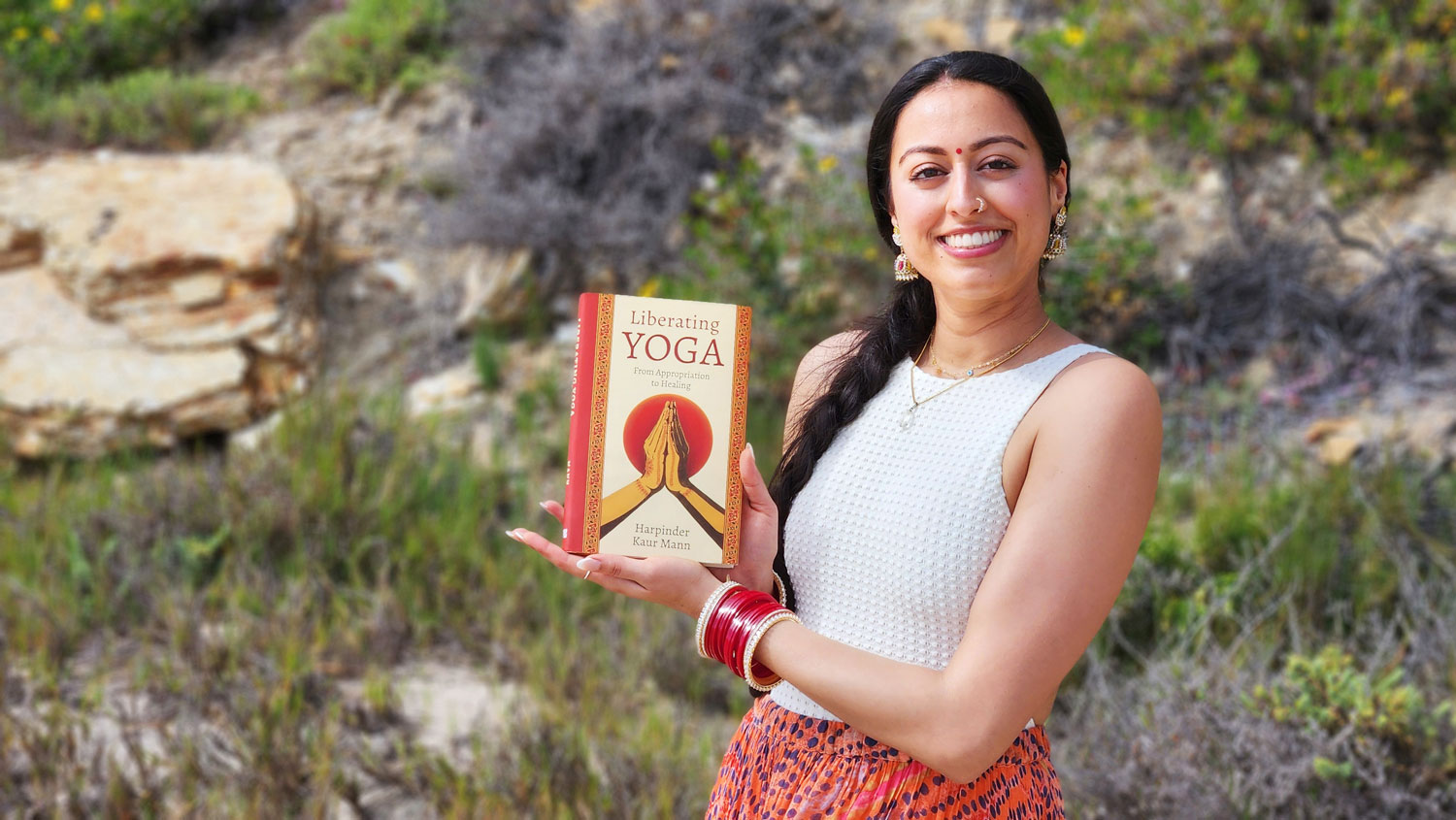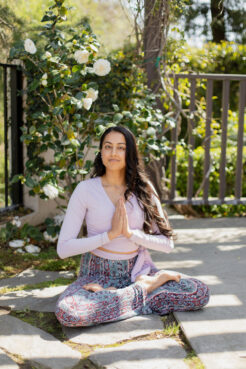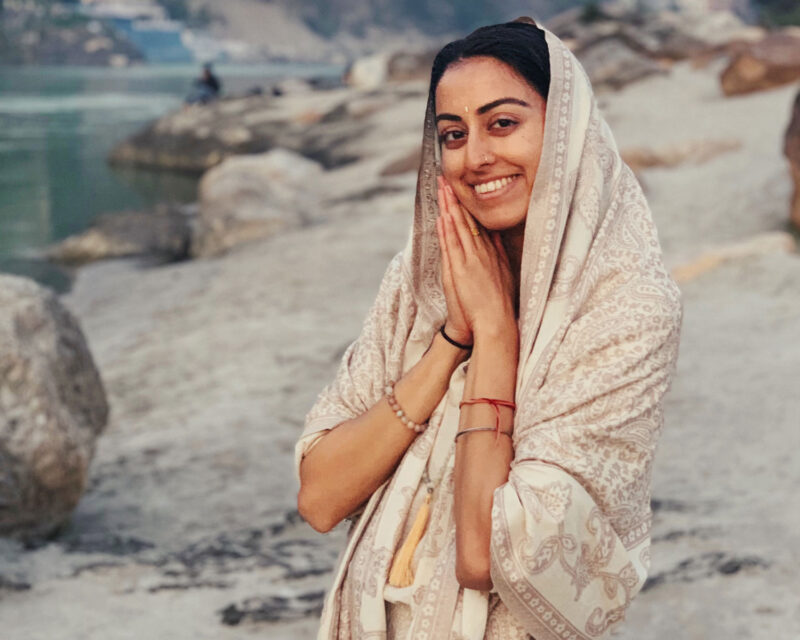
(RNS) — If you ask 10 people in North America what yoga looks like, says writer, yoga teacher and activist Harpinder Kaur Mann, nine might say “a thin woman in leggings holding a pose.”
While yogis wearing Lululemon outfits and teaching CorePower Yoga sweat sessions on Instagram may seem like key-holders to yoga culture for the average Westerner, too often, this sanitization of yoga from anything decidedly “ethnic” fundamentally misses the purpose of the practice, the founder of the podcast Brown Girl Guilt told RNS. It’s not a toning exercise but an introspective path toward self-realization, meant for any body type, gender or outfit, said Mann, who has taught yoga since 2018.
In Mann’s upcoming book, “Liberating Yoga: From Appropriation to Healing” — available from Broadleaf Books on June 3 — the Punjabi American, who resides in Los Angeles, shares her journey to reclaim yoga’s roots in the Dharmic religions, offering a personal yet universal vision of what yoga could look like if it were grounded in decolonization, justice and collective transformation.
This interview has been edited for length and clarity.
Tell me about your spiritual foundation.
My parents immigrated to the U.S. from Punjab in the ’80s and ’90s, and they both really held onto Sikhism. They were both very conservative and very much like, ‘start reading the ‘Guru Granth Sahib’ at the age of 3.’ We’d go to gurdwara every Sunday. It was very ritualistic, sometimes it felt very forced.
I paid for myself to go to UCLA, and then I was just like, ‘That’s it. I am done with religion.’ I am now an atheist. And so, I felt very estranged from being a Punjabi and practicing Sikhi when I went to college, and I felt very lost.
But I knew yoga is this philosophy, this pathway to find your way back home — not as a place, but a sense within. Even at the end of the asana classes that were very much like exercise, I still felt a little bit of peace. It wasn’t until my second job out of college, where we were in India for months at a time and all the teachers were much older, (and) we had very slow asana. We learned meditation. There would be discussions on death and how to live well. And I saw the reverence they had when the gurus would come in. I think it was then that I started to make my way back to my faith. I consider myself interfaith now. On my altar, I have Buddha, I have a Ganesh, I have Durga Mata. It was yoga that brought me back to that.
How did you come to find that Western yoga classes weren’t alright, and how do we change them?
I really thought I would be more welcomed when I walked into my first yoga class. There were so many people there. It was so foggy, it was so steamy, I could barely see the person in front of me. And then the music was just like blaring as we were moving from pose to pose. I couldn’t make sense of how this choreographed dance had to do with yoga as a philosophy and as a pathway of self-realization. I was like, this just feels like a workout class.
We just ask for one class at (a yoga studio) that is like a gentle class, that’s more accessible for all body shapes. Have a class that’s philosophy taught by someone who has deep knowledge of it. Have a Pranayama or meditation class. I was speaking to someone who was saying he wants to teach more of the philosophical part of yoga, but when he reaches out to studios, they’re not really interested.
It’s not all like this, but so much of it is. I feel like some of it is just our modern society where we are needing to move our body more. Yoga gets to be that, so maybe some of our aims are shifting. Maybe we’re moving away from, like, “We want self realization” to “We just want to move our body because we’re so stagnant all day long.” I understand the need for asana, but I think we’re losing the context behind why we’re practicing. And there’s people that know the context, so how can we invite them into these yoga studios?
What is trauma-informed yoga?
Trauma-informed yoga is coming from the understanding that so many of us have had either acute or chronic trauma, have suffered or gone through things that weren’t within our control and our nervous system didn’t know how to react to it. So, (yoga) has come out as a way to support individuals, where in the practice, there is accessibility, there’s choice, there’s consent, there’s modifications. It’s the attunement where I, as a teacher, have to be mindful of my own nervous system — how I am showing up and holding space, the way I’m using language to invite instead of directing or commanding or forcing.
Yoga has traditionally been taught one on one — that student-teacher, mentor-mentee relationship is so important. I have heard from so many people that have come out of yoga teacher training feeling like, “OK, I paid all this money, now what do I do? Where’s the support? Who can help me along this journey?” I was very intentional about having my own yoga mentor that can show a mirror to me, support me when I’m feeling lost or confused. A lot of people are coming to yoga because they’re feeling lost or confused or trying to make sense of life, and are looking for wisdom. Sometimes that’s missing in these spaces.
How does capitalism play a role?
The concept of yoga leggings was created by Lululemon in the ’90s. So it’s really interesting that a company comes out and says, “This is the attire,” and how that’s really shaped the perception of what yoga is and what we feel like we need to wear.
The reason the physical practice has become so popular is because it’s easy to sell. Like, wear this attire, buy this mat, buy these mala beads to look more spiritual, buy these sound bowls to play this Asana teacher. But it’s much harder to package up transformation, self-realization, and sell that. This more subtle transformation that happens with yoga is much harder to show if we’re thinking about social media, because how do we sell that someone has become less angry overall through this practice? How do we sell that someone has worked through a samskara, or a deeply held habit pattern or affliction?
Something I see, and even for myself, is feeling like we need to keep taking trainings, we need to keep buying things to progress along, when none of that is needed. In order for yoga studios to stay in business, oftentimes it’s the yoga teacher trainings that make them the most money. One of my podcast interviewees talks about, if we were to think about yoga as a tea, what’s happening is we have the tea but we keep adding water. Then where’s the tea essence?
In your mind, what can yoga be at its fullest?

Harpinder Kaur Mann and her book “Liberating Yoga: From Appropriation to Healing.” Photo courtesy Mann
I think yoga gets to be this pathway of self-transformation, self-realization that then starts to translate out into the world around us. Sometimes I feel like these classes on philosophy and other things get canceled because teachers or the studio owners (think) people don’t want to learn it or they’re not interested. If someone is a teacher of yoga, even if you find something boring, I don’t care — learn it, it’s a part of yoga. Don’t only turn to yoga as a feel good modality or something for fun, learn the depth of what there is, including the history, the philosophy.
It includes also self-inquiry — turning in and looking at the baggage I’m carrying around. How am I behaving? How can I try to change some of this? I think there would be deeper studentship, and I think there would be much more one-on-one work. I think there would potentially be teachers taking more breaks and studying more themselves.
Why is it important to share your views through the book?
What yoga is teaching us is to let go of identities, of roles, things that keep us bound into separation. How do we all allow ourselves to be more open minded and learn from one another and connect, and also understand that it’s OK for there to be diversity in beliefs and ideas, and to learn from one another?
It does feel like my dharma at the moment. I’m also still in the uncovering of what this looks like. I think there’s a reason I was born into this body, I had the family I did, I’ve had the experiences, the trauma that I had, because it’s all being alchemized into the work I do now.


